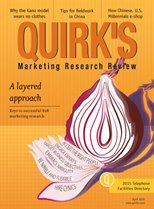Editor's note: Sarah Faulkner is a principal at Faulkner Strategic Consulting, Cold Spring, Ky.
Almost every company does some kind of market research, which can range from the most basic e-mail customer satisfaction survey to massive global studies with half-million-dollar price tags. But no matter the budget or the scope, the sad truth is that a large percentage of consumer and market research is vastly underutilized. I’ve heard more stories than I can tell about missed opportunities: studies commissioned by a person who left the company which are never even glanced at; stacks of dusty, unread research reports; research conducted for a specific objective with the rest of the learning ignored … You get the idea.
The majority of companies have an untapped asset in already-conducted or -purchased consumer and market research studies. There may be missing links between qualitative, quantitative and syndicated research. Your company may have a lot of great consumer research data that hasn’t been adequately translated to conclusions and recommendations for the business. There may be research in one part of the organization with broader application that no one else even knew existed. And sometimes organizations just don’t know what information is being missed. Whatever the situation, an insight audit may be able to help.
An insight audit reviews existing consumer research learning for a few different objectives:
- to glean new insights for a new project or objective from existing data, especially across multiple sources;
- to translate data into action by connecting the dots to develop actionable conclusions and recommendations for the business; and
- to shape future research efforts by identifying what’s already known and where the gaps in knowledge are to develop a new learning plan.
Let’s look at a few examples of companies that used an insight audit to target one or more of the learning objectives detailed above. The first example comes from my own experience with consumer targeting for a personal care category. The brand needed to update its consumer targeting strategy but didn’t have the time or funds to commission a new, dedicated segmentation study. The company did, however, have access to some relevant existing research, including: an outdated category-specific quantitative study, a recent cross-category quantitative study (not specific to this market segment), point-of-sale/market data and some relevant qualitative research. With an extensive mining of the available sources – including quantitative analysis and qualitative insights, as well as an understanding of the current market structure (e.g., versioning and competitive product offerings) – several robust prime prospect consumer groups were identified which filled the immediate business need.
In another example, a pet care company was looking to test concepts for a brand restage. Instead of conducting new qualitative research, the company worked with an external consultant to mine existing qualitative research and seek out key trends and consumer language from secondary, unstructured data found online. The addition of online unstructured data – gathered from blogs, forums and product reviews – helped identify new areas of consumer frustration and unmet needs in the category. This proved to be a more cost- and time-effective approach that allowed the company to develop several compelling positioning concepts for a restage that really resonated with consumers. One of the new concepts based on the insights found in the research – as well as market trends – developed by the consultant became the winning idea.
My last example took place within a company that was struggling with a major strategic decision. Though the company had reams of consumer studies, it was unable to reconcile the disparate pieces of data to come to a clear conclusion. An insight audit was able to pull out several key findings from the reports – which included 100-slide brand equality studies – and combine those with actual in-market results to paint a clear and cohesive picture of the market reality. The company was then able to see the opportunity space, which allowed it to choose the path forward with confidence. Sometimes it really is difficult to see the forest for the trees!
Much like a financial audit, it is often a good idea to bring someone in from outside of the organization to conduct an insight audit. He or she should have deep expertise in a range of consumer research techniques, the ability to synthesize large amounts of information into clear, concise and actionable insights and extensive client-side experience for the application of those insights to the business.
An insight audit will allow your company to establish what is already known as well as find where there are gaps in knowledge or where new research is needed. It also acts as a cost-effective way to gather baseline knowledge and relevant insights for a new project. Insight audits are a way to extract the full benefit of every piece of research – across multiple studies – by translating the data into actionable conclusions and recommendations for your business. An insight audit will not only maximize the value of a company’s existing research investment but it will also result in future research cost savings, which can easily cover the cost of the audit itself.
